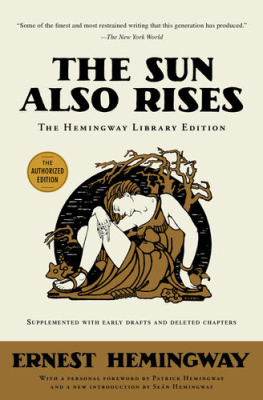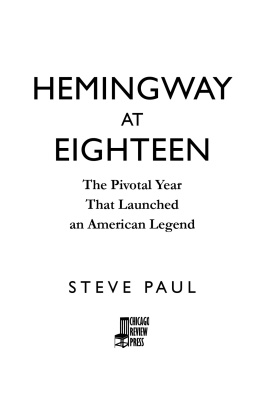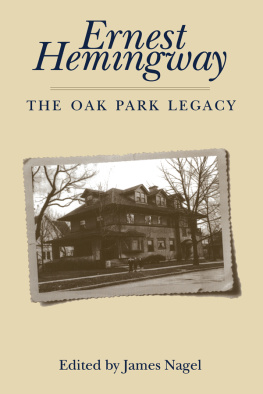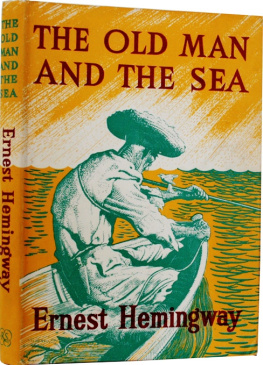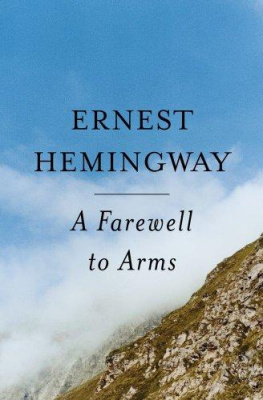Ernest Hemingway: A Biography
Hemingway: The Writer and Legend
I.
Hemingway: The Writer and Legend
Introduction
In arguably his most famous work, Ernest Hemingway wrote, A man can be destroyed, but not defeated. It is perhaps this single line from The Old Man and the Sea that gives the most insight into the mind of one of the greatest writers in American history.
Hemingway was a man who rejected defeat at every opportunity. He was a man whose desire to be the best won him respect, but also lost him friends. He lived his life the way he wanted, rarely stopping to apologize. Even in death, Hemingway proved his determination, trying to take his own life at least twice before he ultimately succeeded with the final blast of a shotgun.
Hemingway served as an ambulance driver for the Red Cross in WWI. While in Italy on duty, he decided that he was not near enough to the action and went closer to the front. Just as he got to the front, an enemy mortar shell exploded in close proximity to Hemingway. Despite being injured in the blast, Ernest found a young Italian soldier who was severely hurt and carried him to safety, taking several rounds of machine gun fire to his leg. For his bravery, Hemingway was awarded the Italian silver medal of valor.
While in the hospital still recovering from his injuries, Hemingway fell in love with a nurse named Agnes von Kurowsky. Ernest had to return to America, but he vowed that one day he would marry von Kurowsky. It was not to be, however, as Hemingway received a letter only months after returning home saying that his love had fallen for an Italian officer . He was devastated, and his initial broken heart may explain why he made a habit out of leaving women before they could leave him. Hemingway was married four times and had affairs in each of his marriages.
Hemingway would again pick up arms and join in the fighting in both the Spanish Civil War and World War II, winning another medal in the latter. He befriended bullfighters in Spain, was present for the invasion of Normandy, and established his name in literature among the giants of the day in Paris. He survived a violent car crash in America, two plane crashes in Africa, and was feared dead when he spent 17 days lost at sea in the Caribbean before returning home with fantastic tales of adventure .
Even without his writing, Hemingways life would be a tale worth telling, but the experiences throughout his life inspired him to write the classics we have come to know him by. A Farewell to Arms is based on his experiences as an ambulance driver in Italy during WWI. The Sun Also Rises is pulled from Hemingways frequent trips from Paris to Pamplona for the bullfights. For Whom the Bell Tolls is written based on his experiences in the Spanish Civil War. Hemingway was also an accomplished fisherman, and his fishing exploits inspired the final novel published during his lifetime, The Old Man and the Sea .
While these classic novels and many of his short stories live in the collective memory of America and the world, they lack significance without a brief understanding of the man behind the works. Hemingway was as fascinating a character as any of those within his writing and over the course of his lifetime he produced a writing style that has since influenced many writers .
Background and Upbringing
Born in Oak Park, Illinois on July 21, 1899, Ernest Hemingway was welcomed to the world by his parents, Clarence Edmonds Hemingway and Grace Hall-Hemingway. His mother, wanting a girl, often dressed Ernest in a bonnet and dress, and had him play with dolls with his older sister, Marcelline.
Ernests father Ed, a doctor, taught Ernest a love and appreciation of the outdoors at a young age. On Ernests third birthday, his father taught him to fish. The two would often hunt and fish together as Ernest was growing up. The Hemingway family had a vacation home called Windemere, close to Walloon Lake in Michigan. The family would take summer vacations to the cabin and it was at Windemere that Ernest earned his great appreciation for nature. Ernest would frequently return to Windemere as an adolescent and young adult as an escape from the pressures in his life.
The Hemingways ran a conservative religious household and expected their children to abide by the rules as they were set forth. As Ernest grew older, he fostered an increasing disdain for the rules and expectations of his parents, especially his mother. I n later years, Ernests dislike for his mother grew into a hatred that he was never able to escape.
Attending Oak Park High School, Ernest got his first taste of published writing. Through the school newspaper the Trapeze , Hemingway was able to write articles and humor pieces for the first time. Hemingway said that his early humor pieces were modeled after popular satirist of the time Ring Lardner.
In 1916, Hemingway attended a boxing match in Chicago and immediately f ell in love with the sport . As a way to release some of his fierce competitive energy, Ernest went to local gyms to watch fighters train and eventually began sparring with friends in his mothers music studio. In what would become a common theme throughout his life, Ernest told friends that he had boxed with many professional fighters in his youth and blamed the poor vision in his left eye on a blow to the head while boxing. This, of course, was false. Hemingway was born with a bad left eye, but he often embellished stories to his friends to make himself seem more masculine or courageous.
After finishing high school, despite having taken college prep courses, Hemingway decided that he did not wish to continue his schooling. This became one of many conflicts with his parents throughout his life. Hemingway mentioned an interest in joining the Army and fighting in WW1, but his bad eyesight meant that he was unable to join. Instead, Ernest found work through a family connection at the Kansas City Star . Hemingway would be taking the place of a reporter who recently had gone to fight in the Great War.
In Kansas City, Hemingway jumped right into the happenings of the city. He integrated himself into the police department and had a reputation for always being on the scene to report the news. While at the Star , Ernest received advice that he held with him for the rest of his life and incorporated into his fiction. His boss at the paper, Pete Wellington, told Hemingway to Use short sentences. Use short first paragraphs. Use vigorous English. Be Positive, not negative.
Despite the hard work he was putting in at the Star , Hemingway still often thought about the war raging across the Atlantic and how he wanted to be involved. Those thoughts became reality after Ernest met Ted Brumback, who had previously been an ambulance driver in France. Together, Hemingway and Brumback signed up to be Red Cross ambulance drivers in Italy. As an 18-year-old, Hemingway was about to get his first taste of war and the flavor of excitement would remain with him throughout his life.
Become a Hyperink reader. Get a special surprise.
Like the book? Support our author and leave a comment!
Hemingway the Writer
II.
Hemingway the Writer
Major Works and Accomplishments
Ernest Hemingway was a writer who achieved as much as could be hoped for any writer throughout his lifetime. His awards and achievements have been well-documented, but it is the stories behind the stories that really bring to light the fascinating journey that was Hemingways life and work.
It was the final novel published before he died that brought Hemingway the most recognition. The Old Man and the Sea was published in 1952, after years of unsuccessful attempts by Hemingway to match the quality and accolades of some of his previous work. After writing The Old Man and the Sea , Hemingway said [this is] the best I can write ever for all of my life.




